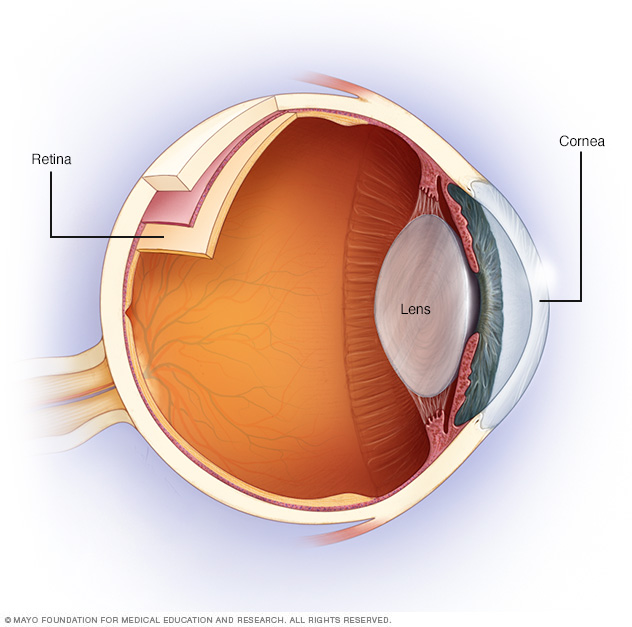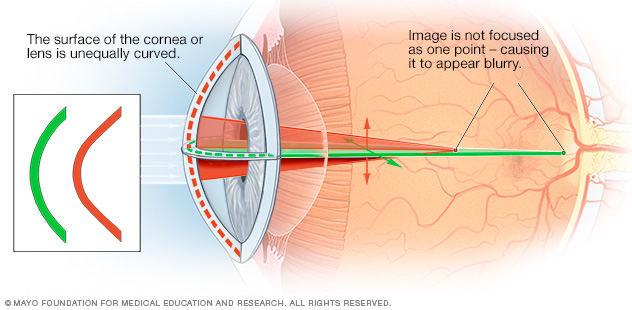Overview
Astigmatism (uh-STIG-muh-tiz-um) is a common and generally treatable imperfection in the curvature of the eye that causes blurred distance and near vision.
Astigmatism occurs when either the front surface of the eye (cornea) or the lens inside the eye has mismatched curves. Instead of having one curve like a round ball, the surface is egg-shaped. This causes blurred vision at all distances.
Astigmatism is often present at birth and may occur in combination with nearsightedness or farsightedness. Often it's not pronounced enough to require corrective action. When it is, treatment options are corrective lenses or surgery.
Symptoms
Signs and symptoms of astigmatism may include:
- Blurred or distorted vision
- Eyestrain or discomfort
- Headaches
- Difficulty with night vision
- Squinting
When to see a doctor
See an eye doctor if your eye symptoms detract from your enjoyment of activities or interfere with your ability to perform everyday tasks. An eye doctor can determine whether you have astigmatism and, if so, to what degree. He or she can then advise you of your options to correct your vision.
Children and adolescents
Children may not realize their vision is blurry, so they need to be screened for eye disease and have their vision tested by a pediatrician, an ophthalmologist, an optometrist or another trained screener at the following ages and intervals.
- During the newborn period
- At well-child visits until they reach school age
- During school years, every 1 to 2 years at well-child visits, at the eye doctor, or through school or public screenings
Causes
Simplified anatomy of the eye

Simplified anatomy of the eye
This simplified illustration of the eye shows the elements most involved in astigmatism: the cornea and the lens.
Astigmatism

Astigmatism
Astigmatism is a type of refractive error caused when either the cornea or the lens has mismatched curves. This makes vision blurry because there are two image points.
The eye has two structures with curved surfaces that bend (refract) light onto the retina, which makes the images:
- The cornea, the clear front surface of the eye along with the tear film
- The lens, a clear structure inside the eye that changes shape to help the eye focus on near objects
In a perfectly shaped eye, each of these elements has a round curvature, like the surface of a smooth ball. A cornea or lens with such curvature bends (refracts) all incoming light equally to make a sharply focused image directly on the retina at the back of the eye.
A refractive error
If either the cornea or the lens is egg-shaped with two mismatched curves, light rays aren't bent the same, which means that two different images form. These two images overlap or combine and result in blurred vision. Astigmatism is a type of refractive error.
Astigmatism occurs when the cornea or lens is curved more steeply in one direction than in another. You have corneal astigmatism if your cornea has mismatched curves. You have lenticular astigmatism if your lens has mismatched curves.
Either type of astigmatism can cause blurred vision. Blurred vision may occur more in one direction: horizontally, vertically or diagonally.
Astigmatism may be present from birth, or it may develop after an eye injury, disease or surgery. Astigmatism isn't caused or made worse by reading in poor light, sitting too close to the television or squinting.
Other refractive errors
Astigmatism may occur in combination with other refractive errors, which include:
- Nearsightedness (myopia). This occurs when the cornea is curved too much or the eye is longer than usual. Instead of being focused precisely on the retina, light is focused in front of the retina, making distant objects seem blurry.
- Farsightedness (hyperopia). This occurs when the cornea is curved too little or the eye is shorter than usual. The effect is the opposite of nearsightedness. When the eye is in a relaxed state, light never comes to a focus at the back of the eye, making nearby objects seem blurry.
Oct. 05, 2021